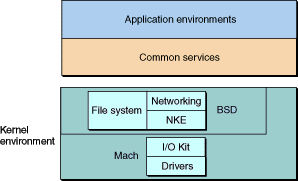ios Architecture
Architecture
The foundation layer of Darwin and OS X is composed of several architectural components, as shown in Figure 3-3. Taken together, these components form the kernel environment.
Figure 3-3 OS X kernel architecture
“A kernel, in traditional operating-system terminology, is a small nucleus of software that provides only the minimal facilities necessary for implementing additional operating-system services.” — from The Design and Implementation of the 4.4 BSD Operating System, McKusick, Bostic, Karels, and Quarterman, 1996.
Similarly, in traditional Mach-based operating systems, the kernel refers to the Mach microkernel and ignores additional low-level code without which Mach does very little.
In OS X, however, the kernel environment contains much more than the Mach kernel itself. The OS X kernel environment includes the Mach kernel, BSD, the I/O Kit, file systems, and networking components. These are often referred to collectively as the kernel. Each of these components is described briefly in the following sections. For further details, refer to the specific component chapters or to the reference material listed in the bibliography.
Because OS X contains three basic components (Mach, BSD, and the I/O Kit), there are also frequently as many as three APIs for certain key operations. In general, the API chosen should match the part of the kernel where it is being used, which in turn is dictated by what your code is attempting to do. The remainder of this chapter describes Mach, BSD, and the I/O Kit and outlines the functionality that is provided by those components.
Mach
Mach manages processor resources such as CPU usage and memory, handles scheduling, provides memory protection, and provides a messaging-centered infrastructure to the rest of the operating-system layers. The Mach component provides
-
untyped interprocess communication (IPC)
-
remote procedure calls (RPC)
-
scheduler support for symmetric multiprocessing (SMP)
-
support for real-time services
-
virtual memory support
-
support for pagers
-
modular architecture
General information about Mach may be found in the chapter Mach Overview. Information about scheduling can be found in the chapter Mach Scheduling and Thread Interfaces. Information about the VM system can be found in Memory and Virtual Memory.
BSD
Above the Mach layer, the BSD layer provides “OS personality” APIs and services. The BSD layer is based on the BSD kernel, primarily FreeBSD. The BSD component provides
-
file systems
-
networking (except for the hardware device level)
-
UNIX security model
-
syscallsupport -
the BSD process model, including process IDs and signals
-
FreeBSD kernel APIs
-
many of the POSIX APIs
-
kernel support for pthreads (POSIX threads)
The BSD component is described in more detail in the chapter BSD Overview.
Networking
OS X networking takes advantage of BSD’s advanced networking capabilities to provide support for modern features, such as Network Address Translation (NAT) and firewalls. The networking component provides
-
4.4BSD TCP/IP stack and socket APIs
-
support for both IP and DDP (AppleTalk transport)
-
multihoming
-
routing
-
multicast support
-
server tuning
-
packet filtering
-
Mac OS Classic support (through filters)
More information about networking may be found in the chapter Network Architecture.
https://developer.apple.com/library/content/documentation/Darwin/Conceptual/KernelProgramming/Architecture/Architecture.html#//apple_ref/doc/uid/TP30000905-CH1g-TPXREF102





